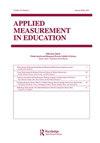答案选项的设置是否为多项选择测试的正确答案提供了线索?系统综述
IF 1.1
4区 教育学
Q3 EDUCATION & EDUCATIONAL RESEARCH
引用次数: 1
摘要
多项选择测试在教育中被广泛使用,通常用于高风险的评估目的。因此,这些测试应按照最高标准进行。已经做出了许多努力来推进旨在改进测试的项目写作指南。一个重要的问题是选项的位置对测试结果的不利影响。任何可能的影响都应通过适当的应对方案安置策略加以控制。然而,关于测试开发人员如何安排选项的文献并不简单。因此,本研究综述系统地回顾了关于遵守期权安置指南的研究。考虑了相关的项目特征,如项目来源(标准化或教师制作的测试)和选项数量。结果表明,答案键在考试中的分布往往存在偏差,这可能为考生选择正确选项提供线索。研究结果还表明,尽管选项适合这样安排,但并不总是以“逻辑”的方式(数字、字母顺序……)排列。讨论了不遵守期权配售指南的原因,以及观察到的响应期权配售策略的适当性。提供建议以帮助开发人员更好地安排项目选项。本文章由计算机程序翻译,如有差异,请以英文原文为准。
Does the Response Options Placement Provide Clues to the Correct Answers in Multiple-choice Tests? A Systematic Review
ABSTRACT Multiple-choice tests are widely used in education, often for high-stakes assessment purposes. Consequently, these tests should be constructed following the highest standards. Many efforts have been undertaken to advance item-writing guidelines intended to improve tests. One important issue is the unwanted effects of the options’ position on test outcomes. Any possible effects should be controlled through an adequate response options placement strategy. However, literature is not straightforward about how test developers arrange options. Therefore, this research synthesis systematically reviewed studies examining adherence to options placement guidelines. Relevant item features, such as the item source (standardized or teacher-made tests) and the number of options were considered. Results show that answer keys’ distribution across tests is often biased, which might provide examinees with clues to select correct options. Findings also show that options are not always arranged in a “logical” fashion (numerically, alphabetically…) despite being suited to be so arranged. The reasons underlying non-adherence to options placement guidelines are discussed, as is the appropriateness of observed response options placement strategies. Suggestions are provided to help developers better arrange items options.
求助全文
通过发布文献求助,成功后即可免费获取论文全文。
去求助
来源期刊

Applied Measurement in Education
Multiple-
CiteScore
2.50
自引率
13.30%
发文量
14
期刊介绍:
Because interaction between the domains of research and application is critical to the evaluation and improvement of new educational measurement practices, Applied Measurement in Education" prime objective is to improve communication between academicians and practitioners. To help bridge the gap between theory and practice, articles in this journal describe original research studies, innovative strategies for solving educational measurement problems, and integrative reviews of current approaches to contemporary measurement issues. Peer Review Policy: All review papers in this journal have undergone editorial screening and peer review.
 求助内容:
求助内容: 应助结果提醒方式:
应助结果提醒方式:


